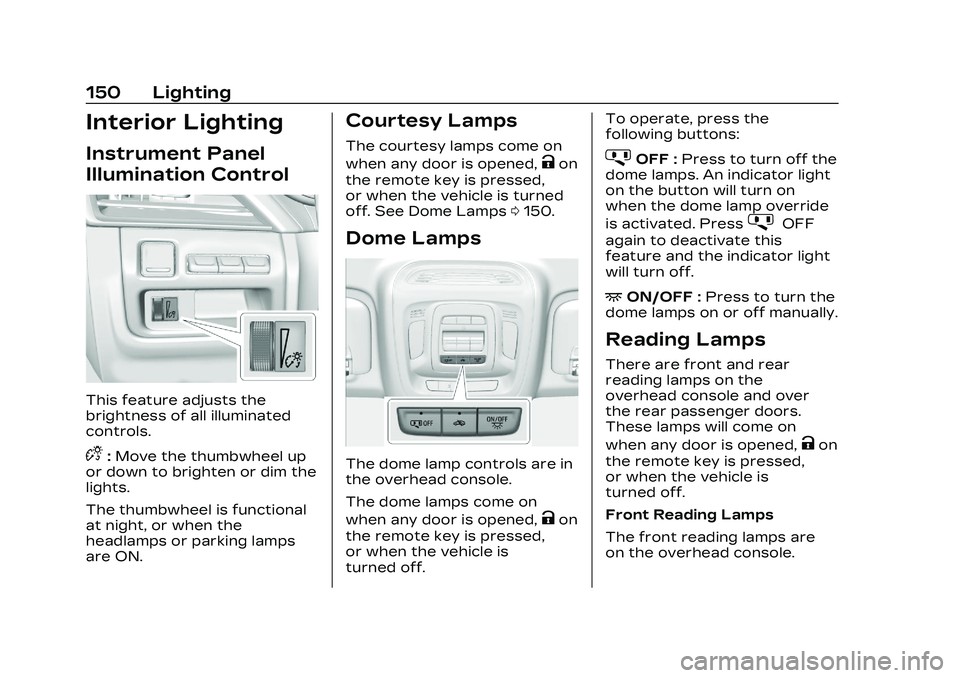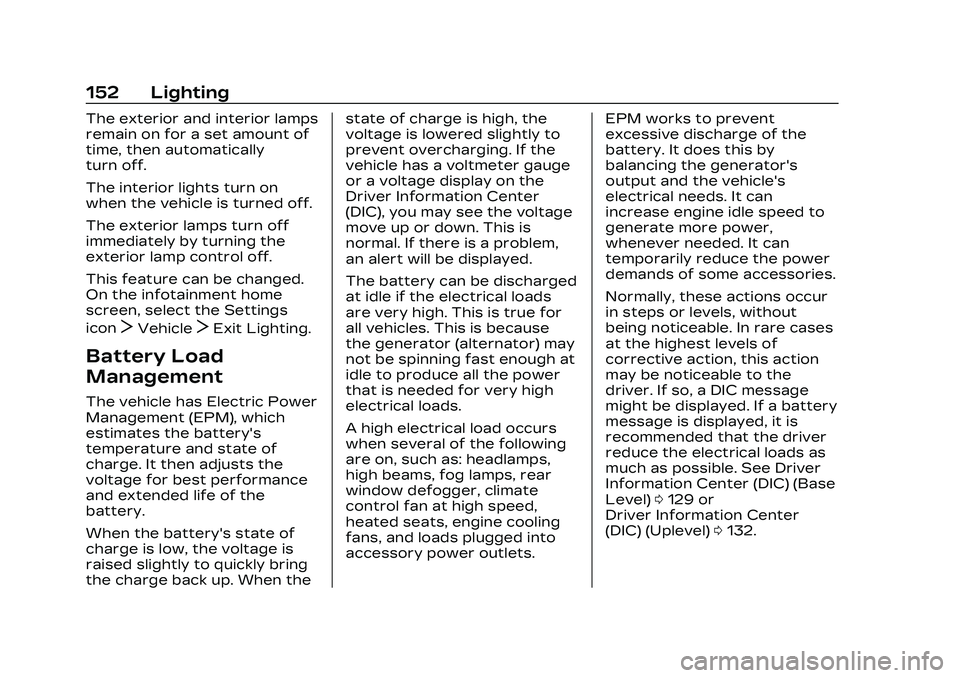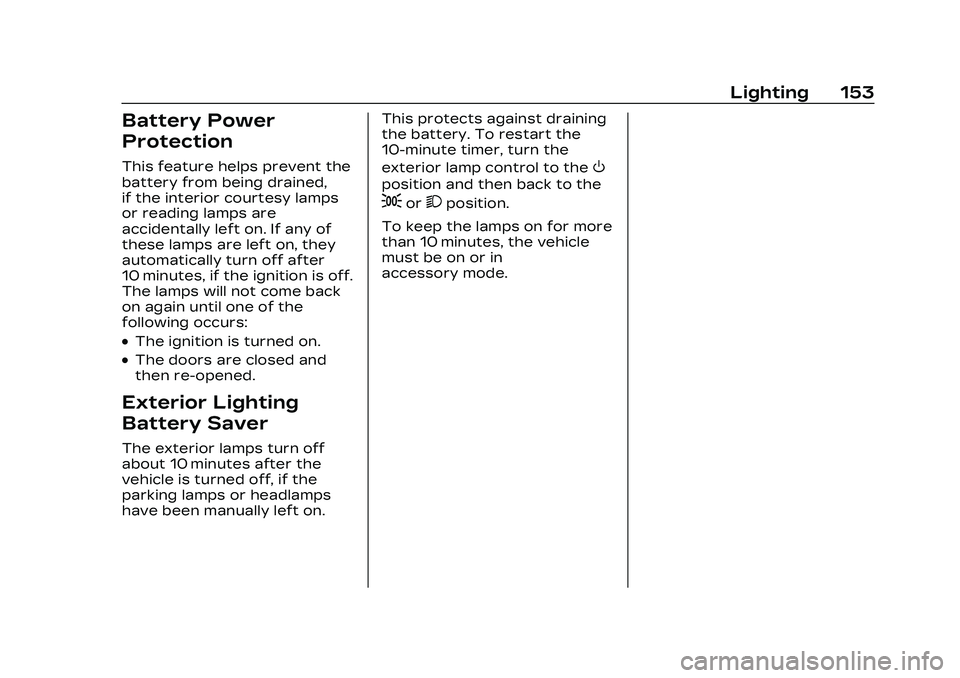headlamp CADILLAC CT4 2023 User Guide
[x] Cancel search | Manufacturer: CADILLAC, Model Year: 2023, Model line: CT4, Model: CADILLAC CT4 2023Pages: 524, PDF Size: 6.98 MB
Page 150 of 524

Cadillac CT4 Owner Manual (GMNA-Localizing-U.S./Canada-16500442) -
2023 - CRC - 5/4/22
Lighting 149
The transition time for the
lamps coming on varies based
on wiper speed. When the
wipers are not operating,
these lamps turn off. Move the
exterior lamp control to
Oor
;to disable this feature.
Hazard Warning
Flashers
|:Press this button to make
the front and rear turn signal
lamps flash on and off.
Release the button for at least
one second and press again to
turn the flashers off. The hazard warning flashers
turn on automatically if the
airbags deploy.
Turn and
Lane-Change Signals
Move the lever all the way up
or down to signal a turn.
An arrow on the instrument
cluster flashes in the direction
of the turn or lane change.
Raise or lower the lever until
the arrow starts to flash to
signal a lane change. Hold it
there until the lane change is
completed. If the lever is
briefly pressed and released,
the turn signal flashes three
times.
The turn and lane-change
signal can be turned off
manually by moving the lever
back to its original position.
If after signaling a turn or lane
change, the arrow flashes
rapidly or does not come on, a
signal function may be
inoperative. This vehicle may
be equipped with LED lighting.
For replacement of any LED
lighting, contact your dealer.
Cornering Lamps
If equipped with cornering
lamps, they automatically
come on when all of the
following occur:
.The low-beam headlamps
are on.
.The turn signals are
activated or the steering
wheel is at a turning angle.
.The vehicle speed is below
40 km/h (25 mph).
Page 151 of 524

Cadillac CT4 Owner Manual (GMNA-Localizing-U.S./Canada-16500442) -
2023 - CRC - 5/4/22
150 Lighting
Interior Lighting
Instrument Panel
Illumination Control
This feature adjusts the
brightness of all illuminated
controls.
D:Move the thumbwheel up
or down to brighten or dim the
lights.
The thumbwheel is functional
at night, or when the
headlamps or parking lamps
are ON.
Courtesy Lamps
The courtesy lamps come on
when any door is opened,
Kon
the remote key is pressed,
or when the vehicle is turned
off. See Dome Lamps 0150.
Dome Lamps
The dome lamp controls are in
the overhead console.
The dome lamps come on
when any door is opened,
Kon
the remote key is pressed,
or when the vehicle is
turned off. To operate, press the
following buttons:
jOFF :
Press to turn off the
dome lamps. An indicator light
on the button will turn on
when the dome lamp override
is activated. Press
jOFF
again to deactivate this
feature and the indicator light
will turn off.
+ON/OFF : Press to turn the
dome lamps on or off manually.
Reading Lamps
There are front and rear
reading lamps on the
overhead console and over
the rear passenger doors.
These lamps will come on
when any door is opened,
Kon
the remote key is pressed,
or when the vehicle is
turned off.
Front Reading Lamps
The front reading lamps are
on the overhead console.
Page 153 of 524

Cadillac CT4 Owner Manual (GMNA-Localizing-U.S./Canada-16500442) -
2023 - CRC - 5/4/22
152 Lighting
The exterior and interior lamps
remain on for a set amount of
time, then automatically
turn off.
The interior lights turn on
when the vehicle is turned off.
The exterior lamps turn off
immediately by turning the
exterior lamp control off.
This feature can be changed.
On the infotainment home
screen, select the Settings
icon
TVehicleTExit Lighting.
Battery Load
Management
The vehicle has Electric Power
Management (EPM), which
estimates the battery's
temperature and state of
charge. It then adjusts the
voltage for best performance
and extended life of the
battery.
When the battery's state of
charge is low, the voltage is
raised slightly to quickly bring
the charge back up. When thestate of charge is high, the
voltage is lowered slightly to
prevent overcharging. If the
vehicle has a voltmeter gauge
or a voltage display on the
Driver Information Center
(DIC), you may see the voltage
move up or down. This is
normal. If there is a problem,
an alert will be displayed.
The battery can be discharged
at idle if the electrical loads
are very high. This is true for
all vehicles. This is because
the generator (alternator) may
not be spinning fast enough at
idle to produce all the power
that is needed for very high
electrical loads.
A high electrical load occurs
when several of the following
are on, such as: headlamps,
high beams, fog lamps, rear
window defogger, climate
control fan at high speed,
heated seats, engine cooling
fans, and loads plugged into
accessory power outlets.
EPM works to prevent
excessive discharge of the
battery. It does this by
balancing the generator's
output and the vehicle's
electrical needs. It can
increase engine idle speed to
generate more power,
whenever needed. It can
temporarily reduce the power
demands of some accessories.
Normally, these actions occur
in steps or levels, without
being noticeable. In rare cases
at the highest levels of
corrective action, this action
may be noticeable to the
driver. If so, a DIC message
might be displayed. If a battery
message is displayed, it is
recommended that the driver
reduce the electrical loads as
much as possible. See Driver
Information Center (DIC) (Base
Level)
0129 or
Driver Information Center
(DIC) (Uplevel) 0132.
Page 154 of 524

Cadillac CT4 Owner Manual (GMNA-Localizing-U.S./Canada-16500442) -
2023 - CRC - 5/4/22
Lighting 153
Battery Power
Protection
This feature helps prevent the
battery from being drained,
if the interior courtesy lamps
or reading lamps are
accidentally left on. If any of
these lamps are left on, they
automatically turn off after
10 minutes, if the ignition is off.
The lamps will not come back
on again until one of the
following occurs:
.The ignition is turned on.
.The doors are closed and
then re-opened.
Exterior Lighting
Battery Saver
The exterior lamps turn off
about 10 minutes after the
vehicle is turned off, if the
parking lamps or headlamps
have been manually left on.This protects against draining
the battery. To restart the
10-minute timer, turn the
exterior lamp control to the
O
position and then back to the
;or2position.
To keep the lamps on for more
than 10 minutes, the vehicle
must be on or in
accessory mode.
Page 256 of 524

Cadillac CT4 Owner Manual (GMNA-Localizing-U.S./Canada-16500442) -
2023 - CRC - 5/10/22
Driving and Operating 255
runs faster than the idle
speed. This keeps the battery
charged to restart the vehicle
and to signal for help with the
headlamps. Do this as little as
possible, to save fuel.
If the Vehicle Is Stuck
Slowly and cautiously spin the
wheels to free the vehicle
when stuck in sand, mud, ice,
or snow.
The Traction Control System
(TCS) can often help to free a
stuck vehicle. See Traction
Control/Electronic Stability
Control0290.
If TCS cannot free the vehicle,
turn TCS off and use the
rocking method. See “Rocking
the Vehicle to Get it Out”
following.
{Warning
If the vehicle's tires spin at
high speed, they can
explode, and you or others
(Continued)
Warning (Continued)
could be injured. The vehicle
can overheat, causing an
engine compartment fire or
other damage. Spin the
wheels as little as possible
and avoid going above
56 km/h (35 mph).
Rocking the Vehicle to Get
it Out
Turn the steering wheel left
and right to clear the area
around the front wheels. Turn
off any traction system. Shift
back and forth between
R (Reverse) and a low forward
gear, spinning the wheels as
little as possible. To prevent
transmission wear, wait until
the wheels stop spinning
before shifting gears. Release
the accelerator pedal while
shifting, and press lightly on
the accelerator pedal when
the transmission is in gear.
Slowly spinning the wheels in
the forward and reverse directions causes a rocking
motion that could free the
vehicle. If that does not get
the vehicle out after a few
tries, it might need to be
towed out. If the vehicle does
need to be towed out, see
Transporting a Disabled
Vehicle (Electronic Shifter)
0
450 or
Transporting a Disabled
Vehicle (Mechanical Shifter)
0 452.Vehicle Load Limits
It is very important to know
how much weight the
vehicle can carry. This
weight is called the vehicle
capacity weight and
includes the weight of all
occupants, cargo, and all
nonfactory-installed
options. Two labels on the
vehicle may show how
much weight it may
Page 317 of 524

Cadillac CT4 Owner Manual (GMNA-Localizing-U.S./Canada-16500442) -
2023 - CRC - 5/10/22
316 Driving and Operating
Do not modify the hood,
headlamps, or fog lamps, as
this may limit the camera’s
ability to detect an object.
Cleaning the Sensing System
The camera sensor on the
windshield behind the
rearview mirror and the radar
sensors on the front of the
vehicle can become blocked by
snow, ice, dirt, or mud. These
areas need to be cleaned for
ACC to operate properly.
If ACC will not operate, regular
Cruise Control may be
available. See“Switching
Between ACC and Regular
Cruise Control” previously in
this section. Always consider
driving conditions before using
either cruise control system.
For cleaning instructions, see
“Washing the Vehicle” under
Exterior Care 0455.Super Cruise
If equipped, Super Cruise can
steer to maintain lane position
under certain conditions on
Super Cruise-enabled roads
that are separated from
opposing traffic.
Super Cruise can also steer to
perform a lane change under
certain conditions on Super
Cruise-enabled roads.
A lane change can be initiated
by the driver using the turn
signal lever. If equipped with
Automatic Lane Change, the
Super Cruise System may
initiate a lane change
maneuver in the following
scenarios:
.To pass slower traffic
.When the current lane is
ending ahead
.To return to the initial lane See
“Super Cruise Lane
Change” later in this section
and Turn and Lane-Change
Signals 0149.
{Warning
Super Cruise can only assist
to maintain lane position,
or steer to change lanes,
when driving on compatible
roads. You must supervise
the driving task and monitor
the road conditions. You
may need to respond to
traffic events by steering,
braking, or accelerating. See
Defensive Driving.
Super Cruise is:
.Not a self-driving system
.Not a crash avoidance or
warning system
.Not a substitute for
proper supervision of the
driving task.
Page 336 of 524

Cadillac CT4 Owner Manual (GMNA-Localizing-U.S./Canada-16500442) -
2023 - CRC - 5/10/22
Driving and Operating 335
.Front and rear bumpers and
the area below the bumpers
.Front grille and headlamps
.Front camera lens in the
front grille or near the front
emblem
.Front side and rear side
panels
.Outside of the windshield in
front of the rearview mirror
.Side camera lens on the
bottom of the outside
mirrors
.Rear side corner bumpers
.Rear Vision Camera above
the license plateRadio Frequency
This vehicle may be equipped
with driver assistance systems
that operate using radio
frequency. See Radio
Frequency Statement
0494.
Assistance Systems
for Parking or
Backing
If equipped, the Rear Vision
Camera (RVC), Rear Park
Assist (RPA), Front Park Assist
(FPA), Surround Vision,
Reverse Automatic Braking
(RAB) and Backing Warning
System, and Rear Cross
Traffic Alert (RCTA) may help
the driver park or avoid
objects. Always check around
the vehicle when parking or
backing.
Rear Vision
Camera (RVC)
When the vehicle is shifted
into R (Reverse), the RVC
displays an image of the area behind the vehicle in the
infotainment display. The
previous screen displays when
the vehicle is shifted out of
R (Reverse) after a short delay.
To return to the previous
screen sooner, press Home or
Back on the infotainment
system, shift into P (Park),
or reach a vehicle speed of
approximately 12 km/h (8 mph)
while in D (Drive).
1. View Displayed by the
Camera
Page 344 of 524

Cadillac CT4 Owner Manual (GMNA-Localizing-U.S./Canada-16500442) -
2023 - CRC - 5/10/22
Driving and Operating 343
feature, touch the Settings
icon on the infotainment home
page. Select“Vehicle”to
display the list of available
options and select “Collision/
Detection Systems”.
Detecting the Vehicle
Ahead
FCA warnings will not occur
unless the FCA system
detects a vehicle ahead. When
a vehicle is detected, the
vehicle ahead indicator will
display green. Vehicles may
not be detected on curves,
highway exit ramps, or hills,
due to poor visibility; or if a
vehicle ahead is partially
blocked by pedestrians or
other objects. FCA will not
detect another vehicle ahead
until it is completely in the
driving lane.
{Warning
FCA does not provide a
warning to help avoid a
crash, unless it detects a
vehicle. FCA may not detect
a vehicle ahead if the FCA
sensor is blocked by dirt,
snow, or ice, or if the
windshield is damaged.
It may also not detect a
vehicle on winding or hilly
roads, or in conditions that
can limit visibility such as
fog, rain, or snow, or if the
headlamps or windshield are
not cleaned or in proper
condition. Keep the
windshield, headlamps, and
FCA sensors clean and in
good repair. Collision Alert
With Head-Up Display
Without Head-Up Display
When your vehicle approaches
another detected vehicle too
rapidly, the red FCA display
will flash on the windshield.
Also, eight rapid high-pitched
beeps will sound from the
front, or both sides of the
Safety Alert Seat will pulse
five times. When this Collision
Alert occurs, the brake system
may prepare for driver braking
to occur more rapidly which
can cause a brief, mild
Page 346 of 524

Cadillac CT4 Owner Manual (GMNA-Localizing-U.S./Canada-16500442) -
2023 - CRC - 5/10/22
Driving and Operating 345
.Clean the headlamps.
Automatic Emergency
Braking (AEB)
If equipped, the AEB system
may help avoid or reduce the
harm caused by front-end
crashes. AEB also includes
Intelligent Brake Assist (IBA).
When the system detects a
vehicle in the path ahead that
is traveling in the same
direction, and that you may
crash into, it can provide a
boost to braking,
or automatically brake the
vehicle. This can help avoid or
lessen the severity of crashes
when driving in a forward gear.
Depending on the situation,
the vehicle may automatically
brake moderately or hard. This
Automatic Emergency Braking
can only occur if a vehicle is
detected. Vehicle detection is
shown by the Forward
Collision Alert (FCA) vehicle
ahead indicator being lit. See
Forward Collision Alert (FCA)
System0342. The system works when
driving in a forward gear
between 8 km/h (5 mph) and
80 km/h (50 mph), or on
vehicles with Adaptive Cruise
Control (ACC), above 4 km/h
(2 mph). It can detect vehicles
up to approximately 60 m
(197 ft).
{Warning
AEB is an emergency crash
preparation feature and is
not designed to avoid
crashes. Do not rely on AEB
to brake the vehicle. AEB will
not brake outside of its
operating speed range and
only responds to detected
vehicles.
AEB may not:
.Detect a vehicle ahead on
winding or hilly roads.
.Detect all vehicles,
especially vehicles with a
trailer, tractors, muddy
vehicles, etc.
(Continued)
Warning (Continued)
.Detect a vehicle when
weather limits visibility,
such as in fog, rain,
or snow.
.Detect a vehicle ahead if it
is partially blocked by
pedestrians or other
objects.
Complete attention is
always required while
driving, and you should be
ready to take action and
apply the brakes and/or
steer the vehicle to avoid
crashes.
AEB may slow the vehicle to a
complete stop to try to avoid a
potential crash. If this
happens, AEB may engage the
Electric Parking Brake (EPB)
to hold the vehicle at a stop.
Release the EPB or firmly
press the accelerator pedal.
Page 348 of 524

Cadillac CT4 Owner Manual (GMNA-Localizing-U.S./Canada-16500442) -
2023 - CRC - 5/10/22
Driving and Operating 347
crashes with nearby
pedestrians when driving in a
forward gear. FPB displays an
amber indicator,
~, when a
nearby pedestrian is detected
ahead. When approaching a
detected pedestrian too
quickly, FPB provides a red
flashing alert on the
windshield and rapidly beeps
or pulses the driver seat. FPB
can provide a boost to braking
or automatically brake the
vehicle. This system includes
Intelligent Brake Assist (IBA),
and the Automatic Emergency
Braking (AEB) System may
also respond to pedestrians.
See Automatic Emergency
Braking (AEB) 0345.
The FPB system can detect
and alert to pedestrians in a
forward gear at speeds
between 8 km/h (5 mph) and
80 km/h (50 mph). During
daytime driving, the system
detects pedestrians up to a
distance of approximately 40 m (131 ft). During nighttime
driving, system performance is
very limited.
{Warning
FPB does not provide an
alert or automatically brake
the vehicle, unless it detects
a pedestrian. FPB may not
detect pedestrians, including
children:
.When the pedestrian is
not directly ahead, fully
visible, or standing upright,
or when part of a group.
.Due to poor visibility,
including nighttime
conditions, fog, rain,
or snow.
.If the FPB sensor is
blocked by dirt, snow,
or ice.
.If the headlamps or
windshield are not cleaned
or in proper condition.
(Continued)
Warning (Continued)
Be ready to take action and
apply the brakes. For more
information, see Defensive
Driving0235. Keep the
windshield, headlamps, and
FPB sensor clean and in
good repair.
FPB can be set to Off, Alert,
or Alert & Brake through
vehicle personalization. To
view available settings for this
feature, touch the Settings
icon on the infotainment home
page. Select “Vehicle”to
display the list of available
options and select “Collision/
Detection Systems”.
Detecting the Pedestrian
Ahead